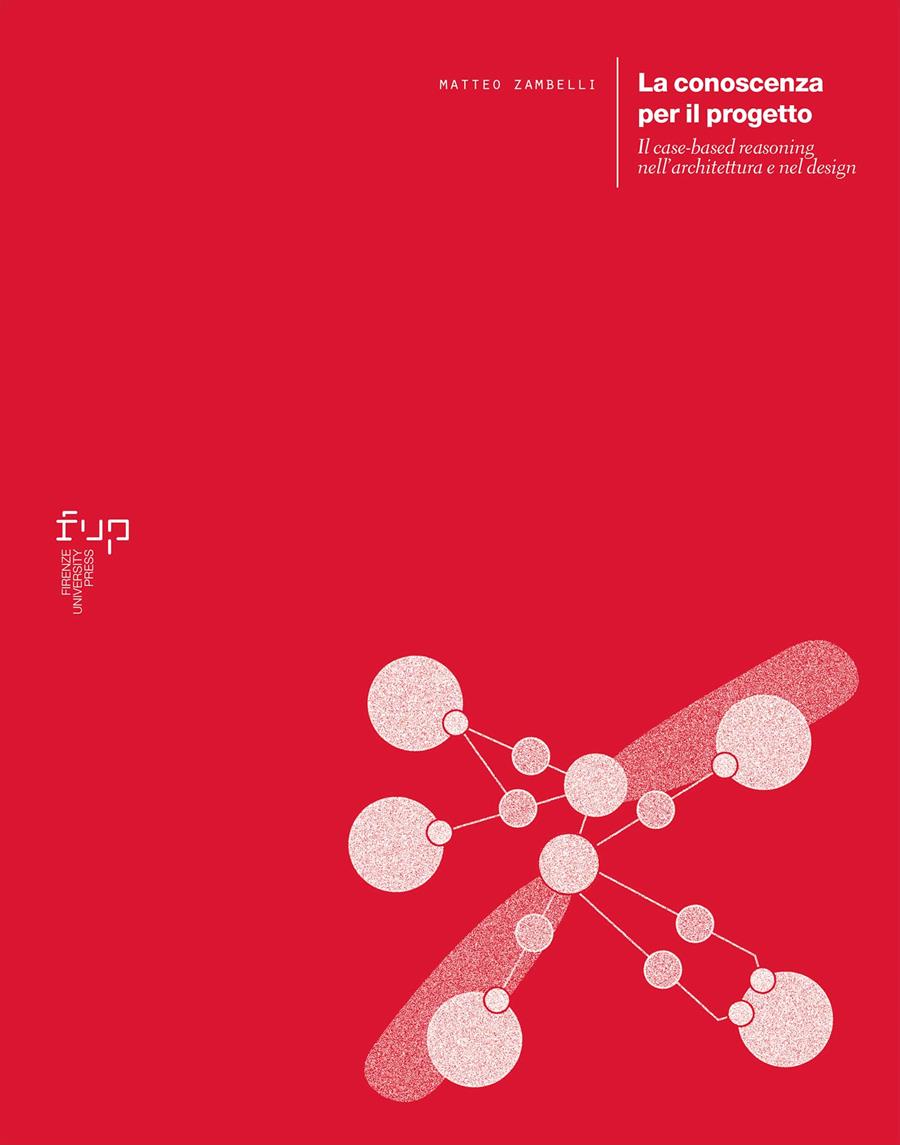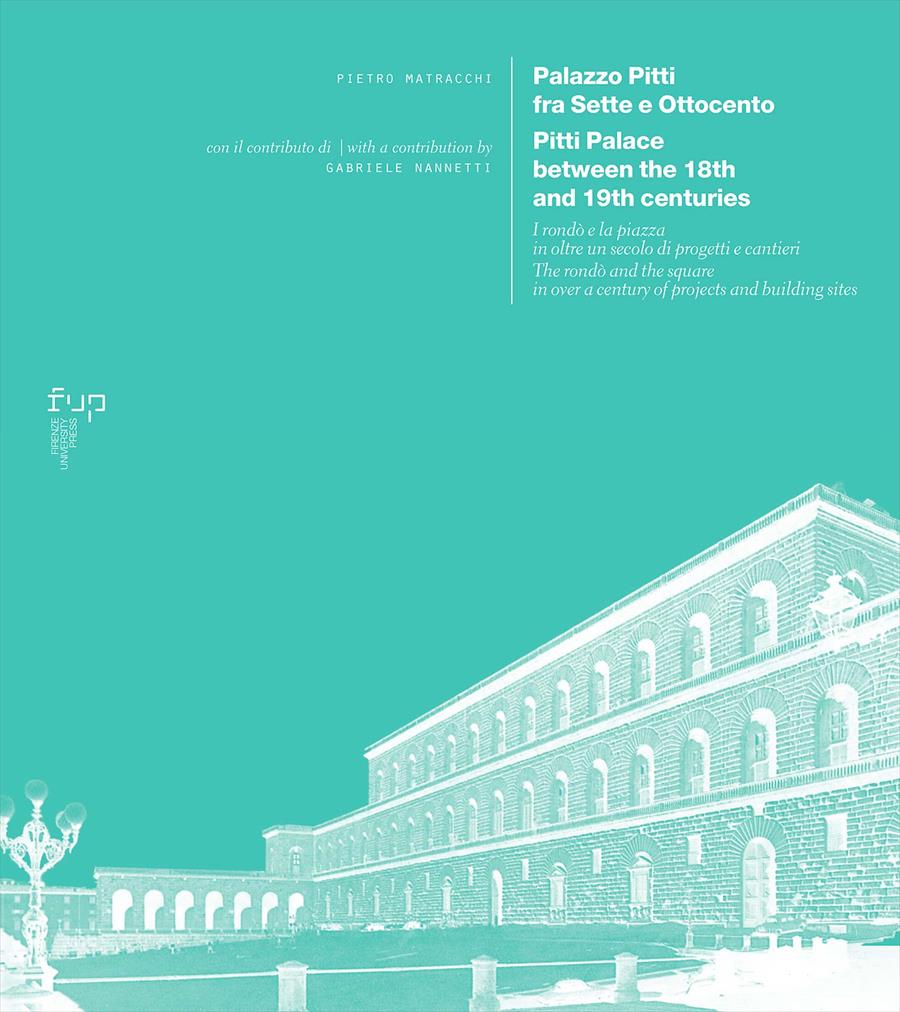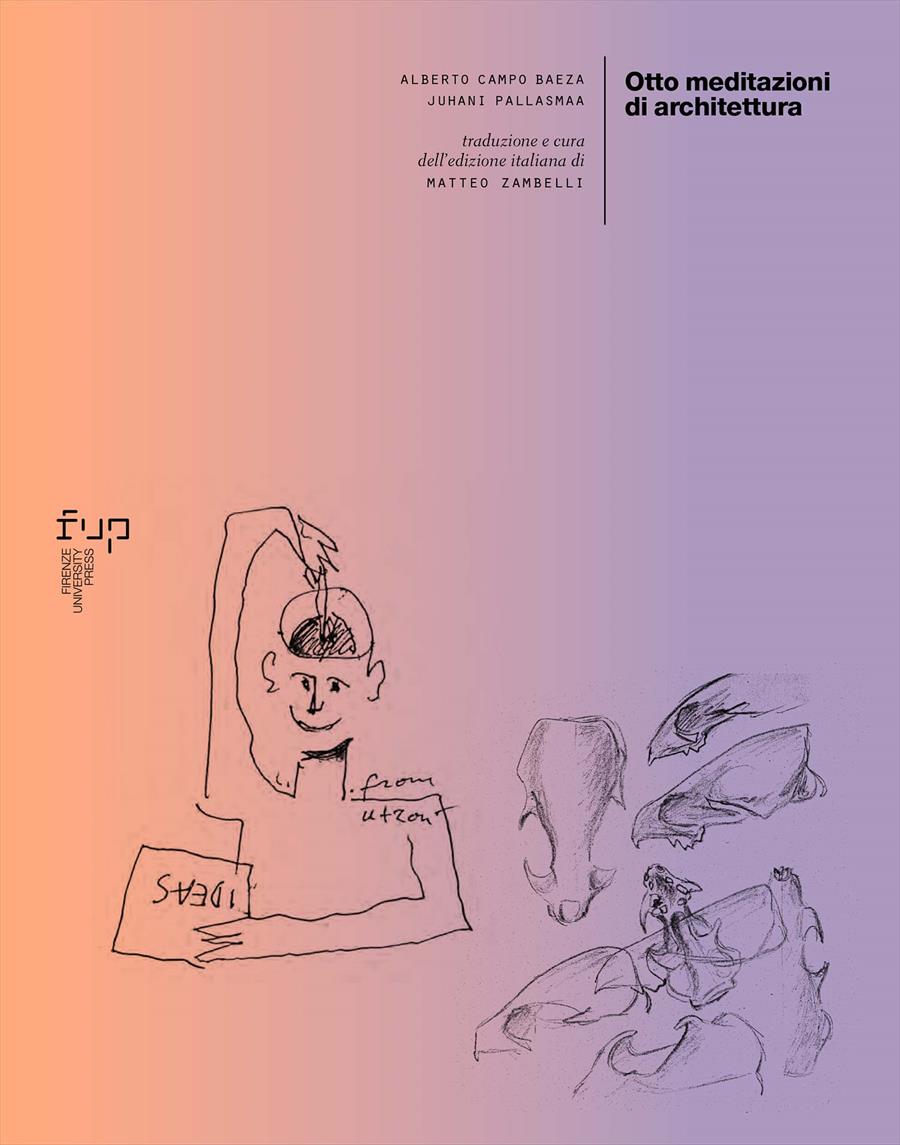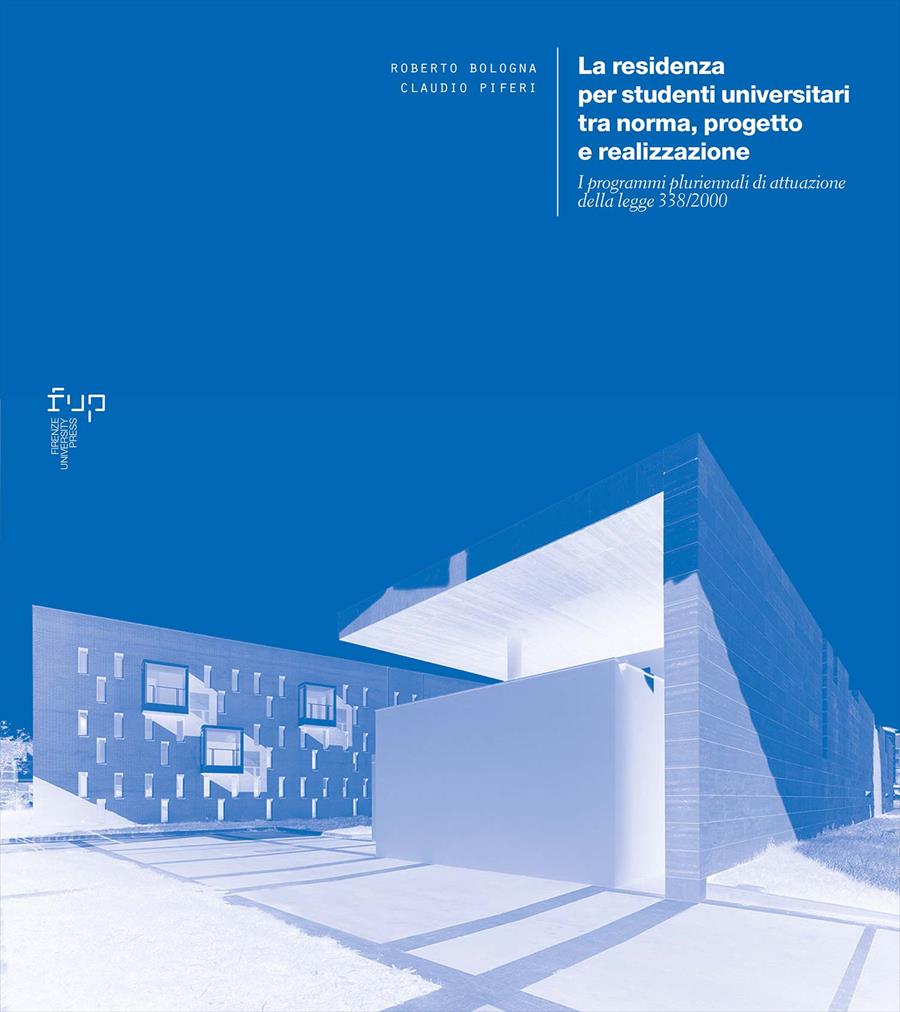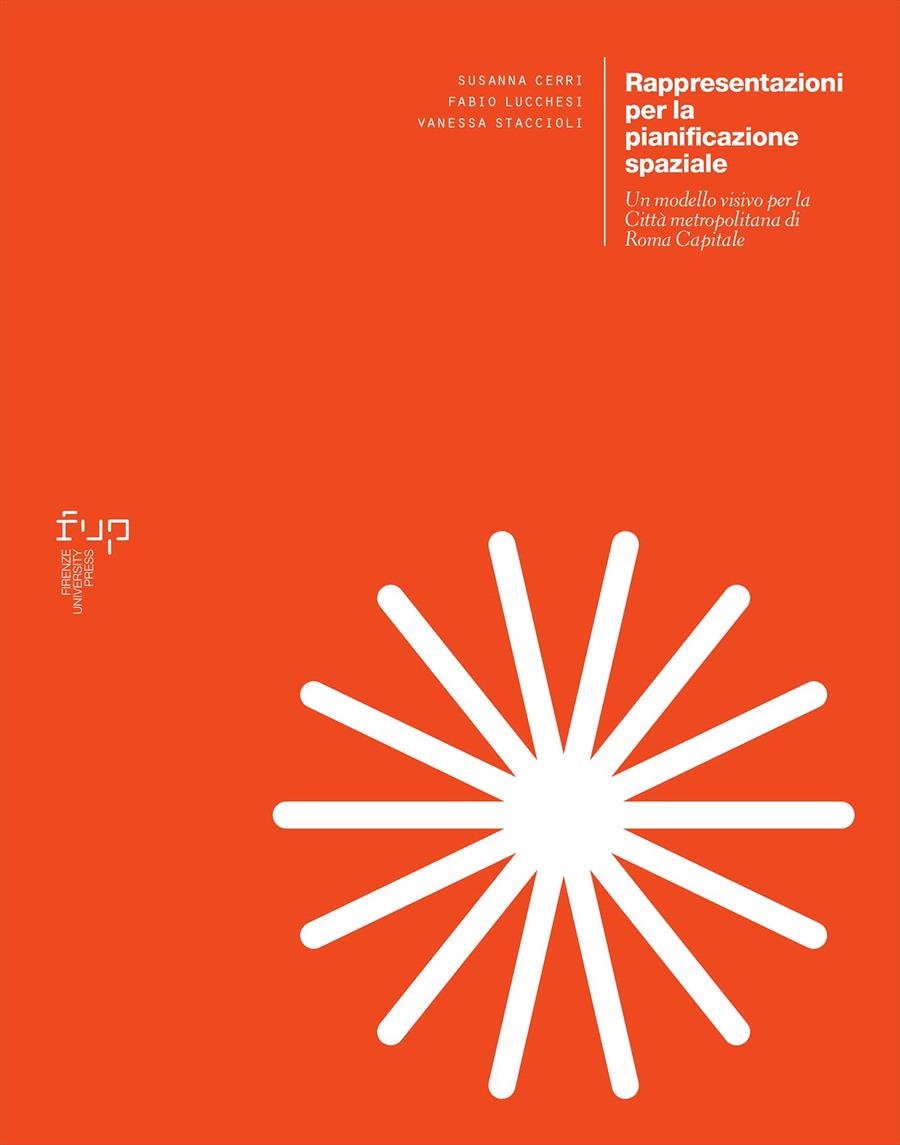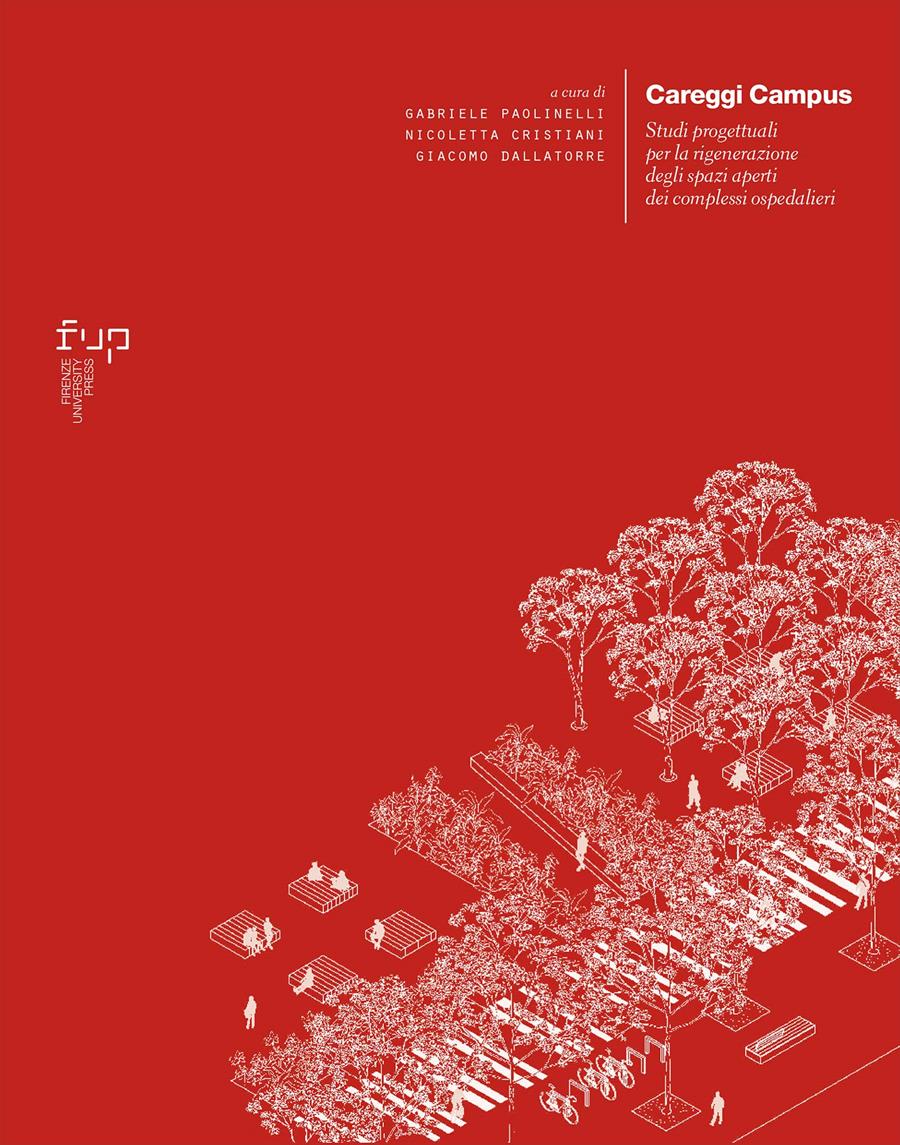La conoscenza per il progetto
Il case-based reasoning nell’architettura e nel design
- Matteo Zambelli,
Case-based reasoning is a cognitive model developed to explain how people reason in problem solving. According to this model, a person resorts to knowledge and strategies used in the past to solve or understand a problem that is similar to the current one. Case-based reasoning applied to design is called case-based design.
La conoscenza per il progetto explains the scientific reasons and why knowledge is crucial to be a good designer and proposes a method for analysing, breaking down and archiving cases of architecture and design (but not only), the typical knowledge of designers, in order to be able to consciously reuse it in a new project.
- Keywords:
- design studies,
- design cognition,
- conceptual maps,
- design education,
- design knowledge,
- DOI: 10.36253/978-88-5518-654-4
- Series: Ricerche. Architettura, Pianificazione, Paesaggio, Design
- Scientific Board
- Language: Italian
- Subjects: Architecture
University of Florence, Italy - ORCID: 0000-0002-9709-0828
- Akin, Ömer, (2002), “Case-based instruction strategies in architecture”, in «Design Studies» n. 23. DOI: 10.1016/S0142-694X(01)00046-1
- Albanese, Ottavia; Doudin, Pierre-André, (2013), Metacognizione ed educazione, Franco Angeli, Milano.
- Antonietti, Alessandro, (2013), Psicologia del pensiero, Il Mulino, Bologna.
- Arielli, Emanuele, (2003), Pensiero e progettazione. La psicologia cognitiva applicata al design e all’architettura, Bruno Mondadori, Milano.
- Arnheim, Rudolph, (1962), Arte e percezione visiva, Feltrinelli, Milano.
- Arredi, Marina Pia, (2006), Analitica dell’immaginazione architettonica per l’architettura, Marsilio Editori, Venezia.
- Ausubel, David P., (2004), Euducazione e processi cognitivi. Guida psicologica per gli insegnanti, Franco Angeli, Milano.
- Bachelard, Gaston, (2006), Psicanalisi delle acque. Purificazione, morte e rinascita, Red Edizioni, Milano.
- Broadbent, Geoffrey, (1988), Design in Architecture. Architecture and the Human Sciences, David Fulton Publishers, London.
- Brodskij, Iosif, (1987), Fuga da Bisanzio, Adelphi, Milano.
- Brodskij, Iosif, (1998), Dolore e ragione, Adelphi, Milano.
- Buzan, Tony, (1987), Usiamo la memoria, Frassinelli, Milano.
- Buzan, Tony, (2003), Usiamo la testa, Frassinelli, Milano.
- Buzan, Tony, (2006), Come realizzare le mappe mentali, Frassinelli, Milano.
- Buzan, Tony, (2015), “Mind Mapping: Scientific Research and Studies”, Think Buzan Ltd.
- Buzan, Tony, (2018), Le leggi delle mappe mentali. Come conoscere il più potente strumento del pensiero per utilizzare al massimo il vostro cervello, Hoepli, Milano.
- Buzan, Tony; Buzan, Barry, (2004), Mappe mentali, Alessio Roberti Editore, Urgnano (BG).
- Campo Baeza, Alberto, (2018), Principia architectonica, Christian Marinotti Edizioni, Milano.
- Cantoia, Manuela; Carrubba, Letizia; Colombo, Barbara, (2004), Apprendere con stile. Metacognizione e strategie cognitive, Carocci Editore, Roma.
- Carnevale, Giancarlo, (1988), La spirale ostinata ovvero il sapere prudente, dispense del corso, Venezia.
- Carnevale, Giancarlo, (1993), Caro studente ti scrivo… Scritti a difesa di un corso, CittaStudi, Milano.
- Castiglioni, Marco, (2004), “Introduzione all’edizione italiana. La psicologia dei costrutti personali di Kelly: le ragioni di una riproposta”, in Kelly, George A., (2004), La psicologia dei costrutti personali. Teoria e personalità, Raffaello Cortina Editore, Milano.
- Corbellini, Giovanni, (2010), Le pillole del dott. Corbellini. Consigli agli studenti di architettura, Lettera22, Siracusa.
- Cosentino, Antonio, (2002), Costruttivismo e formazione. Proposte per lo sviluppo della professionalità docente, Liguori Editore, Napoli.
- Cross, Nigel, (1982), “Designerly ways of knowing”, in «Design Studies» vol. 3, n. 4. DOI: 10.1007/1-84628-301-9
- Cross, Nigel, (2006), Designerly Ways of Knowing, Springer, London.
- Cross, Nigel, (2013), Design Thinking. Understanding How Designer Think and Work, Bloomsbury Academic, London and New York.
- Cross, Nigel, (edited by), (1984), Developments in Design Methodology, John Wiley & Sons, Chichester.
- Cross, Nigel; Christiaans, Henri; Dorst, Kees, (edited by), (1996), Analyzing Design Activity, John Wiley & Sons, Chichester, United Kingdom.
- Curtis, William J.R., (1986), Le Corbusier: Ideas and forms, Rizzoli, New York.
- De Fusco, Renato, (2001a), Trattato di architettura, Laterza, Roma-Bari.
- De Fusco, Renato, (2001b), “Arti visive: un senso da ritrovare”, in «Op. Cit.» n. 111.
- De Fusco, Renato, (2004), Il piacere dell’arte. Capire la pittura, la scultura, l’architettura e il design, Laterza, Roma-Bari.
- De Fusco, Renato, (2007), Imparare a studiare. Il metodo della riduzione culturale, Aracne, Roma.
- Di Nuoscio, Enzo, (2004), Tucidide come Einstein? La spiegazione scientifica in storiografia, Rubettino Editore, Soveria Mannelli.
- Doczi, György, (1981), The Power of Limits. Proportional Harmonies in Nature, Art, and Architecture, Boston, Massachusetts, Shambhala Publications.
- Dutton, Thomas A.; Willenbrock, Laura L., (1989), “Reviewed Works: The Design Studio: An Exploration of its Traditions and Potential”, in «Journal of Architectural Education (1984–), vol. 43, n. 1.
- Eliot, Thomas Stearns,(2010), Il bosco sacro. Saggi sulla poetica e la critica, Bompiani, Milano.
- Fazio, Antonino, (2019), Costruttivismo e teorie dell’apprendimento, Delos Digital srl, Milano.
- Fornero, Giovanni; Tassinari, Salvatore, (2006), Le filosofie del Novecento, Bruno Mondadori, Milano.
- Genet, Jean, (1992), L’atelier di Alberto Giacometti, Il melangolo, Genova.
- Giovannini, Joseph, (1994), “L.A. Trouvée”, in «Zodiac» n. 11.
- Giretti, Alberto, (2004), La mente nel progetto. Cognizione e computazione nel progetto di architettura, Istituto di Architettura, Tecnica e Progettazione Edilizia, Quaderni di Scienza della Progettrazione, Ancona.
- Glasersfeld (von), Ernst, (2015), Il costruttivismo radicale. Una via per conoscere e apprendere, Odradek edizioni, Roma.
- Gnoli, Claudio; Marino, Vittorio; Rosati, Luca, (2006), Organizzare la conoscenza. Dalle biblioteche all’architettura dell’informazione per il web, Hops Tecniche nuove, Milano.
- Goldschmidt, Gabriela, (1991), “The dialectics of sketching”, in «Creativity Research Journal» vol. 4, n. 2. DOI: 10.1080/10400419109534381
- Goldschmidt, Gabriela, (1994), “Visual analogy in design”, in Trappl, R. (edited by), Cybernetics and systems ’94, World Scientific, Singapore.
- Goldschmidt, Gabriela, (1995), “Visual displays for design: imagery, analogy and databases of visual images”, in Koutamanis, Alexander; Timmermans, Harry; Vermeulen, Ilse, (edited by), Visual databases in architecture, Avebury, Aldershot, Brookfield usa, Hong Kong, Singapore, Sydney, pp. 53-74.
- Goldschmidt, Gabriela, (1998), “Creative architectural design: Reference versus precedence”, in «Journal of Architecture and Planning Research» vol. 15, n. 3, Autumn.
- Goldschmidt, Gabriela, (2001), “Visual Analogy: A Strategy for Design Reasoning and Learning”, in Eastman, Charles M.; McCracken, W. Michael; Newstetter, Wendy C., Design Knowing and Learning: Cognition in Design Education, Elsevir Science, Amsterdam, London, New York, Oxford, Paris, Shannon, Tokyo. DOI: 10.1016/B978-008043868-9/50009-7
- Goldschmidt, Gabriela, (2011), “Inspiring design ideas with texts”, in «Design Studies» n. 32. DOI: 10.1016/j.destud.2010.09.006
- Goldschmidt, Gabriela; Smolkov, M., (2006), “Variances in the impact of visual stimuli on design problem solving performance”, in «Design Studies» n. 27, vol. 5. DOI: 10.1016/j.destud.2006.01.002
- Hadid, Zaha, (2003), “Relazione di progetto”, in «Casabella» n. 709, inserto “Concorso di Progettazione per la nuova Stazione Alta Velocità di Firenze”.
- Harvey, David, (1997), La crisi della modernità. Alle origini dei mutamenti culturali, Il Saggiatore, Milano .
- Hertzberger, Herman, (2002), Articulations, Prestel Verlag, Münich.
- Heylighen, Ann, (2000), In case of architectural design. Critique and praise of Case-Based Design in architecture, Tesi di dottorato, Katholieke Universiteit Leuven, Faculteit Toegepaste Wetenschappen Departement architectuur, Stedenbouw en Ruimtelijke Ordening.
- Heylighen, Ann; Verstijnen, Ilse M., (2003), “Close encounters of the architectural kind”, in «Design Studies» vol. 24, n. 4. DOI: 10.1016/S0142-694X(02)00040-6
- Hillier, Bill; Leaman, Adrian (1976), “Architecture as a discipline”, in «J. Archit. Res», vol. 3, n. 1.
- Johnson-Laird, Philip, (1994), Deduzione Induzione Creatività. Pensiero umano e pensiero meccanico, Il Mulino, Bologna.
- Kahneman, Daniel, (2012), Pensieri lenti e veloci, Mondadori, Milano.
- Kelly, George A., (2004), La psicologia dei costrutti personali. Teoria e personalità, Raffaello Cortina Editore, Milano.
- Kiefer, Anselm, (2018), L’arte sopravvivrà alle sue rovine, Feltrinelli, Milano.
- Kolodner, Janet L.; Domeshek, Eric A., (1997), “The Designers’ Muse: Experience to aid conceptual design of complex artifacts”, in Mary Lou Maher, Pearl Pu, (edited by), (1997), Issues and Applications of Case-Based Reasoning to Design, Psychology Press, Lawrence Erlbaum Associates, New York.
- Kolodner, Janet, (1992), “An Introduction to Case-Based Reasoning”, in «Artificial Intelligence Review» n. 6.
- Kolodner, Janet, (1993), Case-Based Reasoning, Morgan Kaufmann Publishers, San Mateo, California. Kindle edition.
- Kolodner, Janet; Riesbeck, Christopher K., (edited by), (1986a), Experience, Memory, and Reasoning, Psychology Press, Lawrence Erlbaum Associates, New York.
- Kolodner, Janet; Simpson, Robert L. Jr., “Problem Solving and Dynamic Memory”, in Kolodner, Janet; Riesbeck, Christopher K., (edited by), (1986b), Experience, Memory, and Reasoning, Psychology Press, Lawrence Erlbaum Associates, New York.
- Lagreca, Immacolata, (2018), “La metacognizione”, in http://www.edscuola.eu/wordpress/?p=100970.
- Lasdun, Denys, (1976), A Language and a Theme: The architecture of Denys Lasdun & Partners, riba Publications Ltd., London.
- Lawson, Bryan, (1979), “Cognitive Strategies in Architectural Design”, in «Ergonomics» n. 22 (1).
- Lawson, Bryan, (1997), Design in Mind, Architectural Press, Oxford.
- Lawson, Bryan, (2004a), What Designers Know, Architectural Press, Oxford.
- Lawson, Bryan, (2004b), “Schemata, gambits and precedent: some factors in design expertise”, in «Design Studies» vol. 25, n. 5. DOI: 10.1016/j.destud.2004.05.001
- Lawson, Bryan, (2006), How Designers Think. The design process demystified, Architectural Press, Oxford.
- Lawson, Bryan, (2019), The Design Student’s Journey, Routledge, Oxon and New York. Kindle edition.
- Lawson, Bryan; Dorst, Kees, (2009), Design Expertise, Architectural Press, New York.
- Mari, Enzo, (2013), Progetto e passione, Bollati Boringhieri, Milano.
- Miller, George A., (1956), “The Magical Number Seven, Plus or Minus Two. Some Limits on Our Capacity for Processing Information”, in «Psychological Review» vol. 101, n. 2.
- Minsky, Marvin, (1985), The Society of Mind, Simon & Schuster Inc., London (UK).
- Morrison, Jasper, (1998), A World without words, Lars Müller Publishers, Zurich, Switzerland.
- Munari, Bruno, (1992), Viaggio nella fantasia, Corraini, Mantova.
- Munari, Bruno, (1999), Fantasia, Laterza, Bari.
- Munari, Bruno, (2003a), Da cosa nasce cosa, Laterza, Roma-Bari.
- Munari, Bruno, (2003b), Viaggio nella fantasia, Corraini, Mantova.
- Munari, Bruno, (2006), Design e comunicazione visiva. Contributo a una metodologia didattica, Laterza, Roma-Bari.
- Munari, Bruno, (a cura di), (1981), Il laboratorio per bambini a Brera, Zanichelli, Milano.
- Murakami, Haruki, (2017), Il mestiere dello scrittore, Einaudi, Torino.
- Novak, Joseph D., (1998), Le tre intelligenze. Come potenziare le capacità analitiche, creative e pratiche, Erickson, Trento.
- Novak, Joseph D., (2002), L’apprendimento significativo. Le mappe concettuali per creare e usare la conoscenza, Erickson, Trento.
- Novak, Joseph D., (2012), Costruire mappe concettuali. Strategie e metodi per utilizzarle nella didattica, Erickson, Trento.
- Novak, Joseph D., Cañas, Alberto J., (2006), “The Theory Underlying Concept Maps and How to Construct Them”, Technical Report ihmc CmapTools 2006-01, Florida Institute for Human and Machine Cognition.
- Novak, Joseph D.; Gowin, Bob D., (1989), Imparando a imparare, sei, Torino.
- Oxman, Rivka E. (1994), “Precedents in Design: A Computational Model for the Organization of Precedent Knowledge”, in «Design Studies», vol. 15, n. 2.
- Oxman, Rivka E. (1999), “Educating the Designerly Thinker”, in «Design Studies» vol. 20, n. 2.
- Oxman, Rivka E., Oxman, Robert (1993), “precedents: Memory Structure in Design Case Libraries”, in U. Flemming and S. Van Wyk, (edited by), caad Futures ‘93, Elsevier Science Publishers.
- Oxman, Rivka, (2001), “The Mind in Design: A Conceptual Framework for Cognition in Design Education”, in Eastman, Charles M.; McCracken, W. Michael; Newstetter, Wendy C., (edited by), Design, Knowing and Learning: Cognition in Design Education, Elsevier Science, Oxford (UK). DOI: 10.1016/B978-008043868-9/50012-7
- Oxman, Rivka, (2003), “Think-Maps: Teaching Design Thinking in Design Education”, in «Design Studies» vol. 25, n. 1. DOI: 10.1016/S0142-694X(03)00033-4
- Oxman, Rivka; Heylighen, Ann, (2001), “A Case with a View. Towards an Integration of Visual and Case-Based Reasoning in Design”, Architectural Information Management, 19th eCAADe Conference Proceedings, Helsinki (Finland) 29-31 August 2001, pp. 336-341. DOI: 10.52842/conf.ecaade.2001.346
- Pallasmaa, Juhani, (2011), Lampi di pensiero, Pendragon, Bologna.
- Pallasmaa, Juhani, (2014), La mano che pensa, Safarà Editore, Pordenone.
- Pallasmaa, Juhani; Zambelli, Matteo, (2020), Inseminations. Seeds for Architectural Thought, Wiley & Sons, Chichester, West Sussex (UK).
- Pawson, John, (2000), Minimun, Phaidon, London.
- Pawson, John, (2017), Spectrum, Phaidon, London.
- Renoir, Jean, (1996), La mia vita, i miei film. Gli occhi dell’amore per raccontare la vita, Marsilio, Venezia.
- Riesbeck, Christopher K.; Schank, Roger C., (1989), Inside Case-Based Reasoning, Lawrence Erlbaum Associates, Publishers, Hillsdale, New Jersey.
- Rosati, Luca, (2007), Architettura dell’informazione. Guida alla trovabilità, dagli oggetti quotidiani al web, Apogeo, Milano.
- Rosati, Luca, (2019), Sense-making. Organizzare il mare dell’informazione e creare valore con le persone, uxu Edizioni, Roma.
- Samsuddin, Ismail, (2008), Architectural education: peer culture in design studio and its relationship with designing interest, A thesis submitted for the requirements of the degree of Doctor of Philosophy, The University of Sheffield School of Architecture.
- Sant’Agostino, (2012), Le confessioni, bur Rizzoli, Milano. Edizione Kindle.
- Schank, Roger C., (1987), Memoria dinamica. Una teoria della rievocazione e dell’apprendimento nei calcolatori e nelle persone, Marsilio Editori, Venezia.
- Schank, Roger C., (1991), Modelli di spiegazione. Comprensione meccanica e comprensione creativa, Mondadori, Milano.
- Schank, Roger C., (1999), Dynamic Memory Revisited, Cambridge University Press, New York.
- Schank, Roger C.; Abelson, Roger P., (1977), Scripts, Plans, Goals, and Understanding. An Inquiry into Human Knowledge Structures, Lawrence Erlbaum Associates, Inc. Publishers, Hillsdale, New Jersey. Kindle edition.
- Schön, Donald Alan, (2006), Formare il professionista riflessivo. Per una nuova prospettiva della formazione e dell’apprendimento, Franco Angeli, Milano.
- Simon, Herbert A., (2000), Scienza economica e comportamento umano, Edizioni di Comunità, Torino.
- Sternberg, Robert J., (1996), “Stili di pensiero”, in «Tecnologie e didattica» n. 10.
- Sternberg, Robert J., (1997), Thinking Styles, Cambridge University Press, Cambridge (UK).
- Stravinskij, Igor, (1995), Poetica della musica, Edizioni Studio Tesi, Pordenone.
- Tavares, Andre; Bandeira, Pedro, (edited by), (2012), Floating Images: Eduardo Souto De Moura’s Wall Atlas, Lars Müller Publishers, Baden, Switzerland.
- Valéry, Paul, (1997), Eupalino o l’Architetto, Edizioni Biblioteca dell’Immagine, Pordenone.
- Van Berkel, Ben; Bos, Caroline, (un Studio), (1999), Move, Publisher un Studio & Goose Press, Amsterdam.
- Vignelli, Massimo, (2012), Il canone Vignelli, Postmedia Books, Milano.
- Visser, Willemien, (1996), “Use of Episodic Knowledge and lnformation in Design nProblem Solving”, in Cross, Nigel; Christiaans, Henri; Dorst, Kees, (edited by), (1996), Analyzing Design Activity, John Wiley & Sons, Chichester, United Kingdom.
- Vitruvio Pollione, Marco, (1990), De architectura, Pordenone, Edizioni Studio Tesi, Pordenone.
- Zambelli, Matteo, (2007), Tecniche di invenzione in architettura. Gli anni del decostruttivismo, Marsilio, Venezia.
- Zambelli, Matteo, (2019), La mente nel progetto. L’analogia e la metafora nell’architettura e nel design, Dida Press, Firenze.
- Publication Year: 2022
- Pages: 184
- eISBN: 978-88-5518-654-4
- Content License: CC BY-NC-SA 4.0
- © 2022 Author(s)
- Publication Year: 2022
- eISBN: 978-88-5518-651-3
- Content License: CC BY-NC-SA 4.0
- © 2022 Author(s)
- Publication Year: 2022
- Pages: 184
- ISBN: 978-88-5518-653-7
- Content License: CC BY-NC-SA 4.0
- © 2022 Author(s)
Bibliographic Information
Book Title
La conoscenza per il progetto
Book Subtitle
Il case-based reasoning nell’architettura e nel design
Authors
Matteo Zambelli
Peer Reviewed
Number of Pages
184
Publication Year
2022
Copyright Information
© 2022 Author(s)
Content License
Metadata License
Publisher Name
Firenze University Press
DOI
10.36253/978-88-5518-654-4
ISBN Print
978-88-5518-653-7
eISBN (pdf)
978-88-5518-654-4
eISBN (xml)
978-88-5518-651-3
Series Title
Ricerche. Architettura, Pianificazione, Paesaggio, Design
Series ISSN
2975-0342
Series E-ISSN
2975-0350
